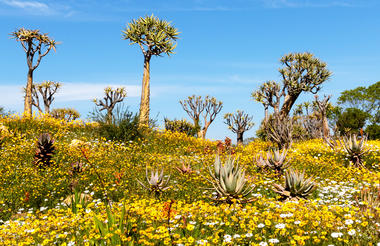Set on the edge of the Swartrand escarpment and serving as a popular stopover for visitors travelling to Sossusvlei and the Duwisib Castle, the village of Maltahohe was established when the District Commissioner of 1899 decided that an outpost further west of the vast, Central Namibian district was required. Maltahohe is home to the oldest hotel in the country, equipped with its original bar and serves as an excellent base from which to explore the scenic surrounding area including a local farm 35 kilometres north of the town that has an 800-hectare shallow pan that, after flooding, is carpeted by a blanket of colourful lilies for about a week before they are devoured by elephant-nosed beetles. Visitors can also look forward to viewing the imposing Dutch Reformed Church in the heart of the village, watching a concert by the local Ama Buruxa choir group, and enjoy a hearty traditional meal. Maltahohe is the perfect spot to take a breather from the road and stock up on supplies before heading off again.



This region is typified by the Succulent Karoo. The distinctive climatic characteristics of the Succulent Karoo make it different from all other deserts in the world. Rainfall is reliable and predictable, falling mostly in winter, and prolonged droughts are rare. The Succulent Karoo’s botanical diversity is unparalleled by any other arid region on earth and is the world’s only plant hotspot that is entirely arid. This ecoregion is home to greater than 5,000 higher plant species, nearly 40 percent of which are endemic, and 18 percent of which are threatened. It has the richest succulent flora in the world, harbouring about one-third of the world’s approximately 10,000 succulent species. Other unique features include the diversity of miniature succulents (435 spp.) and geophytes (bulb-like plants 630 spp.). The ecoregion is also a center of diversity and endemism for reptiles and many invertebrate taxa, especially monkey beetles (Rutelinae: Hoplinii). The Namib Desert ecoregion to the north is characterized by extremely low and variable summer rain (less than 50 mm per year), and extremely sparse plant cover, dominated by ephemerals. To the east lies the Nama Karoo ecoregion, a low open shrubland with variable grass cover and highly variable rain that falls mainly in the late summer months.



The intermittent Fish River has created Africa’s largest and the world’s second largest canyon. Hot, dry and stony the 160 km long, at times 27 km wide and 550m deep canyon is awe inspiring. At the southern end are the renowned hot springs of Ai-Ais.



Every year in early spring, the arid Namaqualand region of South Africa transforms itself into a kaleidoscope of colour with the flowering of thousands of wildflowers. This short-lived, vibrant explosion of colour in what is usually a barren landscape, brings a multitude of local and international visitors who come for the flower season’s endlessly photogenic landscapes, wild flower shows and warm West Coast hospitality.



While the Garden Route remains one of South Africa’s most famous attractions, the West Coast’s isolation and tranquillity appeals to those visitors who seek a break from the hustle and bustle that often accompanies popular tourist attractions and who wish to escape to a place where they can get lost in truly inspiring surroundings. The sparsely populated West Coast offers wide open spaces, unspoilt beaches, rugged terrain and azure seas.







